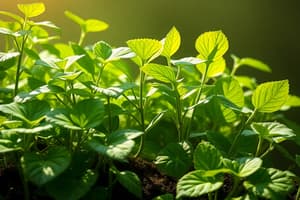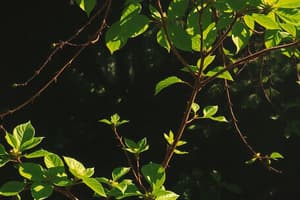Podcast
Questions and Answers
What is the primary site of photosynthesis in plants?
What is the primary site of photosynthesis in plants?
- Chloroplasts (correct)
- Stomata
- Roots
- Flowers
Carnivores primarily consume plants as their main source of nutrition.
Carnivores primarily consume plants as their main source of nutrition.
False (B)
Name one product of the photolysis of water during photosynthesis.
Name one product of the photolysis of water during photosynthesis.
Oxygen
Photosynthesis requires ________, water, and light energy.
Photosynthesis requires ________, water, and light energy.
Match the type of nutrition to its description:
Match the type of nutrition to its description:
Which of the following processes is NOT considered a life process?
Which of the following processes is NOT considered a life process?
All organisms that depend on others for food are classified as autotrophs.
All organisms that depend on others for food are classified as autotrophs.
What is the main process by which autotrophic organisms prepare their food?
What is the main process by which autotrophic organisms prepare their food?
Humans primarily utilize ______ nutrition, which involves ingestion and digestion of complex food.
Humans primarily utilize ______ nutrition, which involves ingestion and digestion of complex food.
Match the types of heterotrophic nutrition with their definitions:
Match the types of heterotrophic nutrition with their definitions:
Which enzyme is responsible for converting starch into simple sugars in the mouth?
Which enzyme is responsible for converting starch into simple sugars in the mouth?
Egestion refers to the absorption of nutrients into the bloodstream.
Egestion refers to the absorption of nutrients into the bloodstream.
What is the role of villi in the human digestive system?
What is the role of villi in the human digestive system?
The process of breaking down large insoluble molecules into smaller, soluble ones is called __________.
The process of breaking down large insoluble molecules into smaller, soluble ones is called __________.
Match the following steps of nutrition with their descriptions:
Match the following steps of nutrition with their descriptions:
What is the main digestive action that occurs in the stomach?
What is the main digestive action that occurs in the stomach?
The small intestine is where most nutrient absorption takes place.
The small intestine is where most nutrient absorption takes place.
What is the primary function of bile juice in digestion?
What is the primary function of bile juice in digestion?
Flashcards
Photosynthesis Equation
Photosynthesis Equation
6CO2 + 12H2O → C6H12O6 + 6O2 + 6H2O
Photosynthesis Site
Photosynthesis Site
Chloroplasts
Photosynthesis Conditions
Photosynthesis Conditions
Carbon dioxide, water, and light energy are required
Herbivore
Herbivore
Signup and view all the flashcards
Omnivore
Omnivore
Signup and view all the flashcards
Ingestion
Ingestion
Signup and view all the flashcards
Digestion
Digestion
Signup and view all the flashcards
Absorption
Absorption
Signup and view all the flashcards
Assimilation
Assimilation
Signup and view all the flashcards
Egestion
Egestion
Signup and view all the flashcards
Teeth and enzymes role in digestion
Teeth and enzymes role in digestion
Signup and view all the flashcards
Villi in absorption
Villi in absorption
Signup and view all the flashcards
Role of bile in digestion
Role of bile in digestion
Signup and view all the flashcards
Nutrition in living organisms
Nutrition in living organisms
Signup and view all the flashcards
Autotrophic nutrition
Autotrophic nutrition
Signup and view all the flashcards
Heterotrophic nutrition
Heterotrophic nutrition
Signup and view all the flashcards
Photosynthesis
Photosynthesis
Signup and view all the flashcards
Holozoic nutrition
Holozoic nutrition
Signup and view all the flashcards
Study Notes
Introduction to Life Processes
- Living organisms perform various life processes, such as growth, respiration, digestion, excretion, and reproduction.
- These processes distinguish them from non-living things.
Nutrition
- Nutrition is the intake of nutrients and their utilization for biological activities.
- Autotrophs produce their own food (e.g., plants, algae).
- Heterotrophs obtain food from other organisms (e.g., animals, humans).
- Holozoic obtain solid or liquid food (e.g., Amoeba, humans).
- Parasitic obtain food from a host (e.g., worms).
- Saprophytic obtain food from dead or decayed organisms (e.g., yeast, mushrooms).
Photosynthesis
- Autotrophs perform photosynthesis, a process to prepare food.
- Chlorophyll-containing cells use carbon dioxide and water in the presence of light to produce glucose, releasing oxygen as a byproduct.
- 6CO2 + 12H₂O → C₆H₁₂O₆ + 6O₂ + 6H₂O (Equation for photosynthesis)
Nutrition in Humans
- Steps of human nutrition include ingestion, digestion, absorption, assimilation, and egestion.
- Digestion involves converting large, complex food molecules into simpler forms.
- Organs of the digestive system include mouth, esophagus, stomach, intestines, liver, pancreas, and others.
Respiration
-
Respiration is the breakdown of glucose to release energy using oxygen. This is then used by cells for bodily functions.
-
The equation for aerobic respiration is C₆H₁₂O₆ + 6O₂ → 6CO₂ + 6H₂O + Energy.
Transportation in Humans and Plants
- Transportation in humans involves the circulatory system which is made up of the heart, blood vessels, and blood.
- In plants, xylem transports water and minerals, while phloem transports food.
- Blood pressure is the force exerted by blood on the walls of the blood vessels.
Excretion in Humans and Plants
- Excretion in humans involves removing metabolic wastes such as urea and excess water through the kidneys.
- Plants expel carbon dioxide and excess water through processes like transpiration and through stomata.
Control and Coordination in Humans
- The nervous system and endocrine system coordinate and control actions.
- Neurons are the basic units of the nervous system.
- Neurons transmit impulses to coordinate various bodily activities.
- Synapse is a point of contact between neurons, where signals are passed via chemical neurotransmitters.
Control and Coordination in Plants
- Plants also exhibit coordination and control through hormones (e.g., auxin).
- Growth responses to stimuli are called tropisms (e.g., phototropism, geotropism).
Reproduction
- Reproduction is the process by which new organisms are produced.
- Asexual reproduction is reproduction with a single parent, whereas sexual reproduction involves two parents.
Heredity
- Genetics is the study of how traits are passed from parents to offspring.
- The study of heredity includes Mendel's laws (dominance, segregation, and independent assortment).
Evolution
- Evolution is the gradual development of organisms over time.
- Natural selection and genetic variation drive evolution.
- Fossils provide evidence of past life and evolutionary changes.
Studying That Suits You
Use AI to generate personalized quizzes and flashcards to suit your learning preferences.




